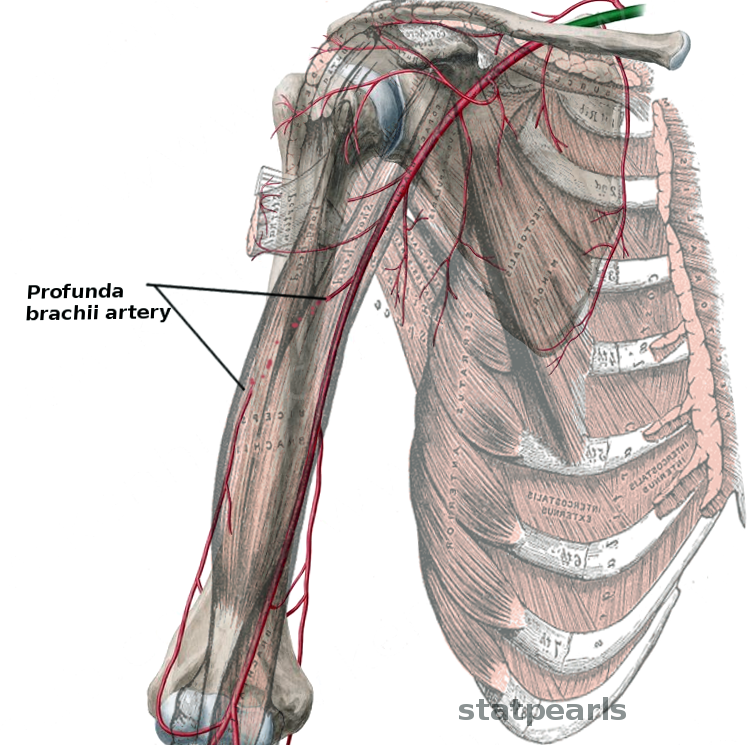[1]
Casoli V, Kostopoulos E, Pélissier P, Caix P, Martin D, Baudet J. The middle collateral artery: anatomic basis for the "extreme" lateral arm flap. Surgical and radiologic anatomy : SRA. 2004 Jun:26(3):172-7
[PubMed PMID: 14730394]
[2]
Sun R, Ding Y, Sun C, Li X, Wang J, Li L, Yang J, Ren Y, Zhong Z. Color Doppler Sonographic and Cadaveric Study of the Arterial Vascularity of the Lateral Upper Arm Flap. Journal of ultrasound in medicine : official journal of the American Institute of Ultrasound in Medicine. 2016 Apr:35(4):767-74. doi: 10.7863/ultra.15.01032. Epub 2016 Mar 11
[PubMed PMID: 26969598]
[3]
Chakravarthi KK, Ks S, Venumadhav N, Sharma A, Kumar N. Anatomical variations of brachial artery - its morphology, embryogenesis and clinical implications. Journal of clinical and diagnostic research : JCDR. 2014 Dec:8(12):AC17-20. doi: 10.7860/JCDR/2014/10418.5308. Epub 2014 Dec 5
[PubMed PMID: 25653931]
[4]
Lai CS, Lin SD, Chou CK, Tsai CC. The reverse lateral arm flap, based on the interosseous recurrent artery, for cubital fossa burns. British journal of plastic surgery. 1994 Jul:47(5):341-5
[PubMed PMID: 8087373]
[5]
Meirer R, Schrank C, Putz R. Posterior radial collateral artery as the basis of the lateral forearm flap. Journal of reconstructive microsurgery. 2000 Jan:16(1):21-4; discussion 24-5
[PubMed PMID: 10668750]
[6]
Sauerbier M, Germann G, Giessler GA, Sedigh Salakdeh M, Döll M. The free lateral arm flap-a reliable option for reconstruction of the forearm and hand. Hand (New York, N.Y.). 2012 Jun:7(2):163-71. doi: 10.1007/s11552-012-9395-3. Epub
[PubMed PMID: 23730235]
[7]
Rivet D, Buffet M, Martin D, Waterhouse N, Kleiman L, Delonca D, Baudet J. The lateral arm flap: an anatomic study. Journal of reconstructive microsurgery. 1987 Jan:3(2):121-32
[PubMed PMID: 3560037]
[8]
Ekim H, Tuncer M. Management of traumatic brachial artery injuries: a report on 49 patients. Annals of Saudi medicine. 2009 Mar-Apr:29(2):105-9
[PubMed PMID: 19318753]
[9]
McCready RA. Upper-extremity vascular injuries. The Surgical clinics of North America. 1988 Aug:68(4):725-40
[PubMed PMID: 3046002]
[10]
Devale MM, Munot RP, Bhansali CA, Bhaban ND. Awkward defects around the elbow: The radial recurrent artery flap revisited. Indian journal of plastic surgery : official publication of the Association of Plastic Surgeons of India. 2016 Sep-Dec:49(3):357-361. doi: 10.4103/0970-0358.197235. Epub
[PubMed PMID: 28216816]
[11]
Maruyama Y, Takeuchi S. The radial recurrent fasciocutaneous flap: reverse upper arm flap. British journal of plastic surgery. 1986 Oct:39(4):458-61
[PubMed PMID: 3779192]

